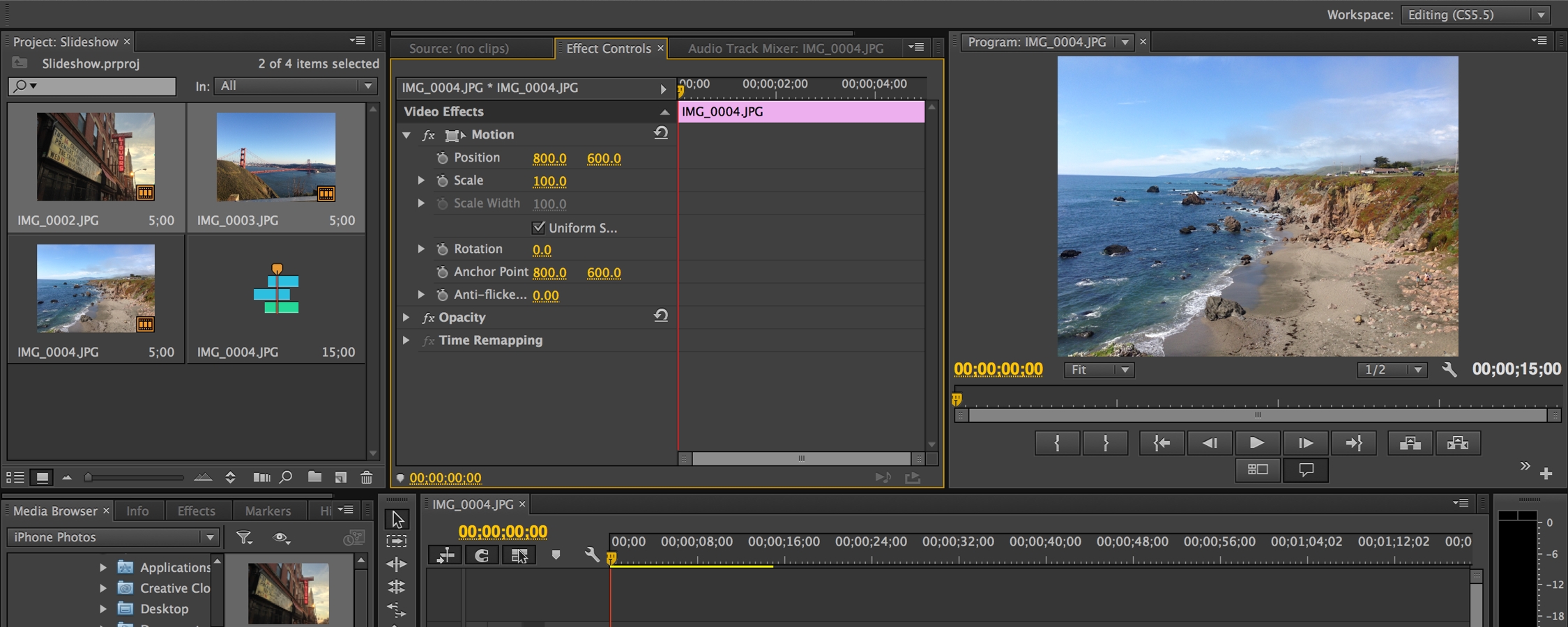GPU Performance
For our GPU centric test we used the following hardware:
| Motherboard: | Asus X99 Deluxe II/U3.1 |
| CPU: | Intel Core i7 6950X 3.0GHz (3.4-4.0GHz Turbo) Ten Core |
| RAM: | 8x Samsung DDR4-2133 32GB ECC Reg. (256GB total) |
| Hard Drive: | Samsung 850 Pro 512GB SATA 6Gb/s SSD |
| OS: | Windows 10 Pro 64-bit |
| PSU: | EVGA SuperNOVA 1200W P2 |
| Software: | Premiere Pro CC 2015.3 |
Premiere Pro can heavily utilize the CPU, although in our CPU-based testing we have found that there is only a relatively small benefit to using a workstation with dual Xeon CPUs. Because of this, we are simply going to test with a single configuration using an Intel Core i7 6950X CPU. While there are faster CPU configurations you could use depending on if you export to 1080p or 4K+ resolutions, this is still a great all-around CPU for Premiere Pro which makes it ideal for comparing different video cards.
The different video cards we will be testing are:
- 1-2x Nvidia GeForce GTX 980 Ti 6GB
- 1-2x EVGA GeForce GTX 1060 6GB
- 1-2x Nvidia GeForce GTX 1070 8GB
- 1-2x Nvidia GeForce GTX 1080 8GB
- 1-2x Nvidia GeForce Titan X 12GB (Pascal)
Exporting to 1080p - Single GPU
While more and more people are starting to shoot in 4K and higher resolutions, 1080p is still by far the most common resolution to export to. Because of this, we thought we would start our testing by looking at how Premiere Pro is able to utilize a single GPU when exporting from a variety of resolutions and codecs to H.264 1080p:
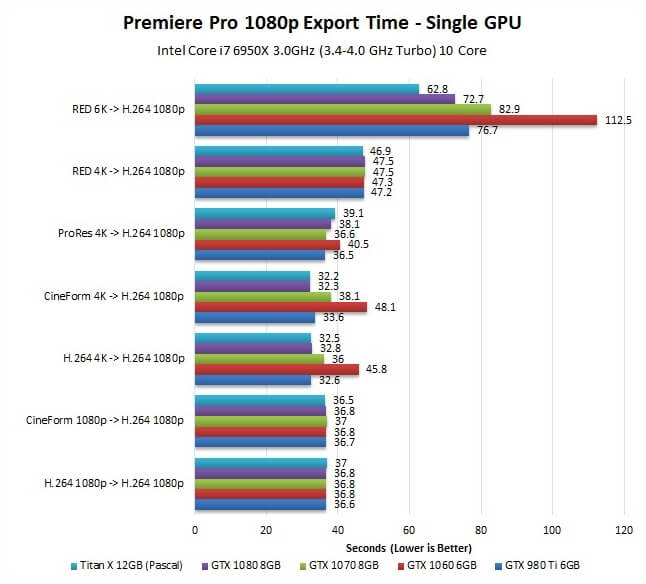
Right off the bat, we are getting some very interesting results. In some instances (H.264 1080p, CineForm 1080p, and RED 4K) we saw essentially no difference between any of the cards we tested. Others (ProRes 4K) showed some minor differences, but they were only minor and not consistent - the more powerful cards were sometimes slower than the less powerful cards.
However, there were three times where you would notice the difference with a more powerful video card. If you work with H.264 or CineForm 4K footage and export to 1080p, there is a definitely an increase in performance by using a GTX 1070, and a further increase by using a GTX 1080. While these two tests did not show a benefit to using a Titan X, Exporting RED 6K footage to 1080p did show a pretty significant decrease in export times when using a Titan X.
Exporting to 1080p - Dual GPU

With two video cards, our results are quite a bit different than what we saw with a single GPU. This time, the only time we saw an advantage to using more power cards was when exporting RED 6K footage to H.264 1080p. Even then, even the GTX 1070 was able to match the GTX 1080 or Titan X.
What is really interesting here is that if you compare these results to the results from our single GPU test in the previous section, it becomes clear that we are definitely hitting some sort of bottleneck that is preventing the workstation from exporting any faster. In most cases, a single GTX 1080 is going to be faster than any dual GPU configuration (with the exception of RED 6K where you would need a Titan X to match the performance of two GTX 1070/1080 video cards). We are confident that we are not hitting a storage bottleneck (we tested with faster storage to make sure), but it is possible we are hitting a CPU bottleneck even though we are using one of the fastest CPUs currently available for Premiere Pro. No matter what is causing us to hit this performance wall, however, our testing indicates that with current hardware there is rarely a need for a dual GPU configuration if you are primarily concerned about performance when exporting to 1080p.
Exporting to 4K - Single GPU
Although 4K isn't as widespread as 1080p quite yet, more and more Premiere Pro users are either exporting to 4K or are considering exporting to 4K in the near future. Exporting to higher resolutions is more taxing on the system as a whole, so it will be interesting to see if the difference between each video card changes when exporting to 4K versus exporting to 1080p:
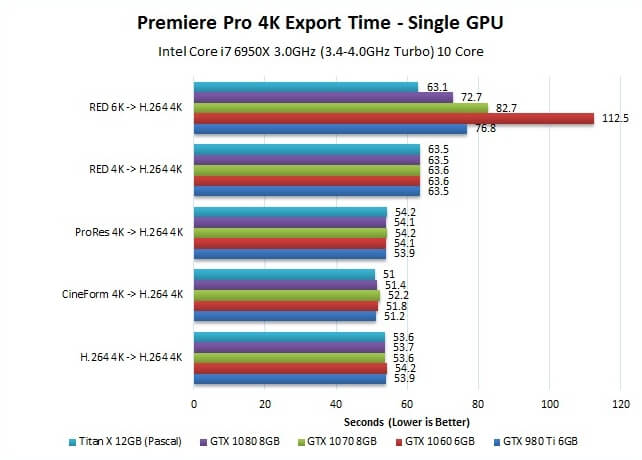
With the export resolution turned up to 4K, we actually saw no difference between the different video card models when exporting any of the 4K footage (regardless of codec) to H.264 4K. However, we did see a big difference when we scaled the RED 6K footage down to 4K. What is interesting is that most of the performance gains we saw when exporting to 1080p in the previous two sections was when we started with higher resolution footage and downscaled to 1080p. While not conclusive, this does suggest that a more powerful video card is more likely to be beneficial if you export to a lower resolution than your source footage.
Exporting to 4K - Dual GPU

With two video cards, there isn't really much to discuss. Exporting RED 6K footage to H.264 4K was the only time we saw a difference in performance, but even then there was no reason to go to anything more powerful.
However, if you again compare the single GPU results to the results in this section, you will notice that using two cards is rarely faster than using a single card. In fact, the only time is is faster is if you are using RED 6K footage. Even then, a single Titan X is as fast as any dual GPU configuration - even two Titan X's. Technically, two GTX 1070 cards would be cheaper than a single Titan X so there may be a cost reason to go with dual cards if you work with 6K+ footage, but at that resolution the additional VRAM on the Titan X is likely to be very useful. In addition, single GPU configurations tend to be more stable in the long term with fewer driver or software bugs popping up at random times.
Render Previews - Single GPU
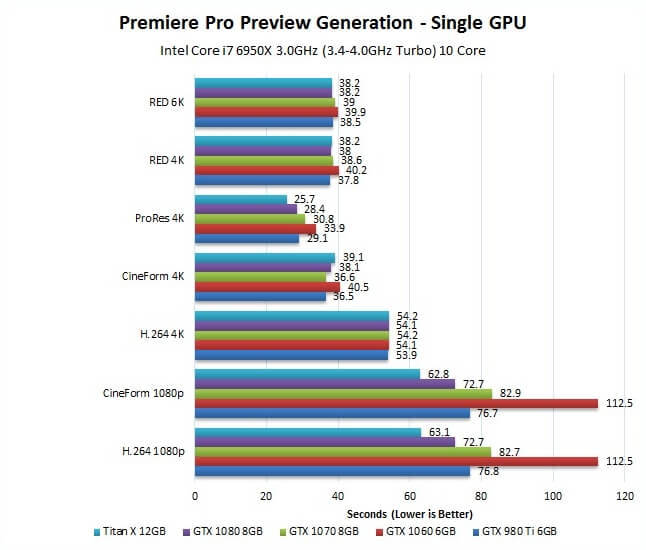
Rendering previews is very interesting because - for whatever reason - the results are almost the opposite of what we saw when exporting to 1080p. This time, with the exception of ProRes 4K, the different video cards were all able to generate previews for the 4K and 6K footage at approximately the same speed. In fact, only the 1080p footage (both H.264 and CineForm) showed a benefit to using a higher end GPU.
Render Previews - Dual GPU
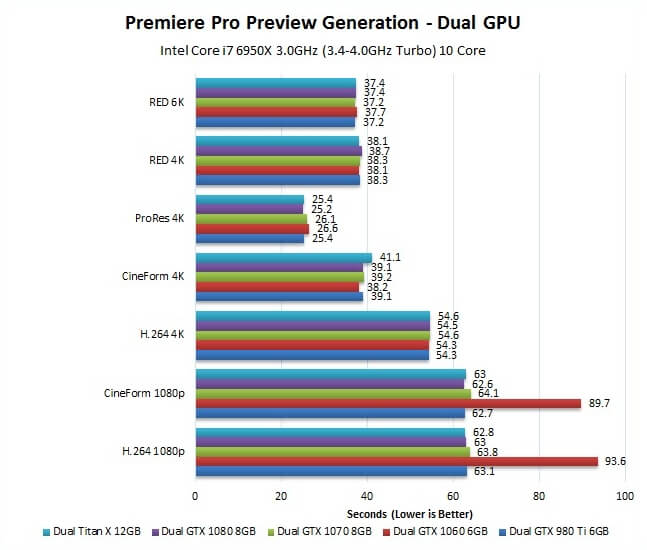
If you read the earlier sections, this is probably starting to look familiar. In a couple of instances there is a pretty big benefit to upgrading from two GTX 1060s to two GTX 1070s, but no benefit to using a GTX 1080 or Titan X. However, if you once again compare these results to the single GPU results in the previous section, it is clear that for generating previews there is rarely a need to use a dual GPU configuration. Two GTX 1070 are certainly cheaper than a single Titan X and gives nearly identical performance when working with 1080p footage, but the downsides to multi GPU configurations are very likely to outweigh the difference in cost for most users.
Final Thoughts
If there is one thing we learned in our testing, it is that the performance difference between the cards can change drastically depending on what source codec and resolution you use as well as what resolution you are exporting to. So if you tend to only work with one of the codecs we specifically tested, we highly recommend simply looking at those results and ignoring everything else.
With that said, however, there are a few broad conclusions we can make based on our results:
- In most situations, there is no need to use a dual GPU configuration. In some situations, dual GPUs can be faster than a single card, but we found that a single higher-end card (typically a Titan X) was able to match any dual GPU configuration we tested. If you happen to work with the type of footage where we saw a benefit to multiple video cards and are on a tight budget, you may consider using two GTX 1070's over a single Titan X. However, at that price point you are likely to find the additional VRAM on the Titan X to be very useful. In addition, single GPU configurations tend to be more stable in the long term with fewer driver or software bugs popping up at random times.
- When exporting, a faster GPU is more likely to give you a performance benefit if your source footage is a higher resolution than the export resolution. We saw a very distinct trend where the different model of video cards performed identically when the source and export resolution was the same. This doesn't mean you will always see a benefit from a faster GPU when you export to a lower resolution than your source footage, but in four of the six benchmarks we ran where this was the case, there was a very distinct performance advantage to using a higher-end video card.
- Generating previews saw the biggest variance between the different GPU models with 1080p footage. ProRes 4K also saw a benefit, but all the others (H.264 4K, CineForm 4K, RED 4K, and RED 6K) saw virtually no difference in the time it took to generate previews with the different video cards.
Keep in mind that the more GPU accelerated effects you use, the larger the difference between each of the models we tested should become - so if you tend to use a lot of the accelerated effects the GTX 1080 and Titan X should provide an even larger benefit than what we showed in this article.
